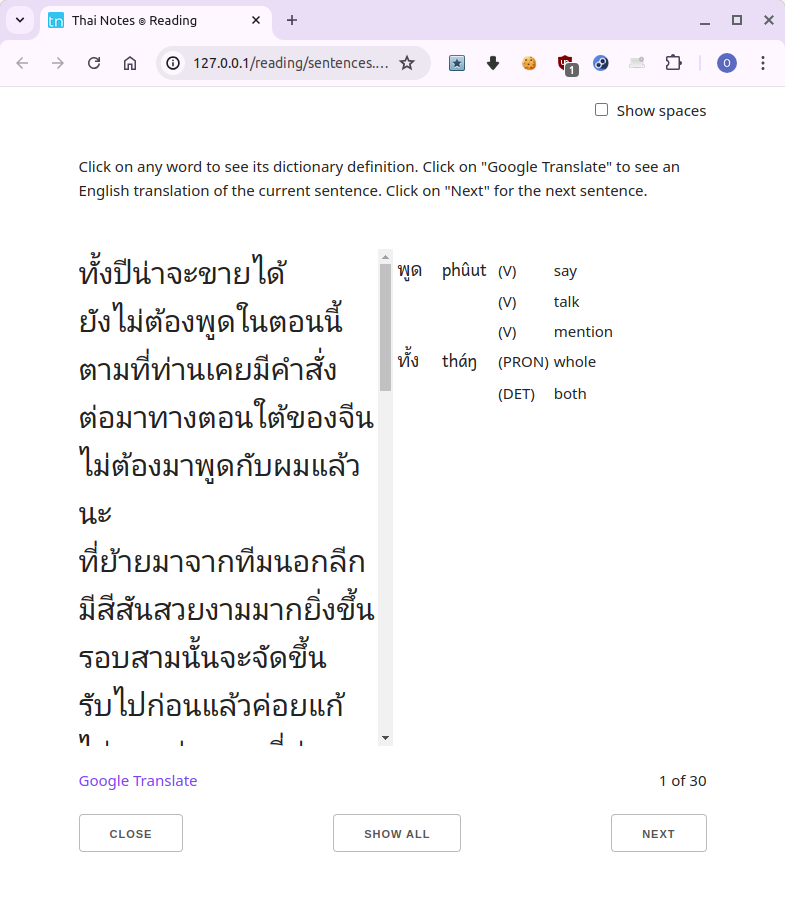-
Posts
136 -
Joined
-
Last visited
Content Type
Events
Forums
Downloads
Quizzes
Gallery
Blogs
Posts posted by ThaiNotes
-
-
13 hours ago, transpose said:
Thank you for your replies. Yes, it sounds mid tone to me. I got the tone partly from http://thai-language.com/dict, saL watL deeM I suppose วั makes it a dead ending. On https://thai-notes.com/reading/tonerules.html, it says a high consonant live is rising and dead is low. Would you say then that this is over simplifying matters because it does not mention stress?
It is oversimplifying. That's why the site has a reading course at https://thai-notes.com/reading/index.html
The subject of unstressed "a" is covered in lessons 27 and 28.
That covers the tone of the first syllable. Had you spotted that the tone of the second syllable is not what you'd expect? วัส = low class consonant + short vowel + dead final. According to the chart, that should be high tone. Indeed, วัด, which follows the same pattern is high tone, /wát/. However, in สวัสดี วัส is low tone. That's also covered in lesson 27.
I would suggest:
(1) You use a dictionary that gets the tones right. I've previously linked to Haas. The other one I would suggest is at https://thai-notes.com/dictionaries/predictionarysearch.html but it does not include glottal stops in the transcription. Wait until you can read Thai script fluently and accurately, so can ignore then transcription, before using the likes of thai-language.(2) Work your way through the reading course (link above). There are so many complexities and irregularities with written Thai, it would take an age to learn about all of them working piecemeal.
Finally, let me pick you up on one tiny thing:
On 3/2/2025 at 6:16 PM, transpose said:Why is ส in สวัสดี low tone but ส is a high tone consonant?
ส is not a "high tone consonant" , it's a high class consonant. There is no direct relationship between a consonant's class and the tone is produces.-
 1
1
-
-
- Popular Post
- Popular Post
11 hours ago, transpose said:Why is ส in สวัสดี low tone but ส is a high tone consonant?
It is not low tone. It's mid tone in normal speech because the syllable is unstressed. If you have a look at the Haas Thai Learners' Dictionary (available online at https://thai-notes.com/dictionaries/haas.html) you'll see it's pronounced /saˈwàtˈdii/. Note it also doesn't have a glottal stop. (For comparison, สระ with a stressed "a" is transcribed as /ˈsàʔ/ - same source.)
Thai people have a false view of how their language is pronounced, probably because they can't actually spell out a mid tone short vowel. Unfortunately, almost all Thai teachers and learners' dictionaries get this wrong. Material from AUA and the Union method do get it right.
Don't believe me? Let me quote a couple of authorities:
David Smyth in "Thai: An Essential Grammar"
“When the vowel in the first syllable is -a ... in normal speech the tone is mid”James Higbie & Snee Thinsan in "Thai Reference Grammar"
“In spoken Thai, unstressed syllables in multisyllable words maybe given mid tones in stead of the high, low or rising tone they should have according to Thai spelling. In this book the common spoken form is used, and these syllables are given mid tones.”-
 2
2
-
 1
1
-
Download and Install the new font on your PC.
Close Excel (if it's not already closed), then open Excel. The new font should now appear on the list.
With thaifonts.org, most of the fonts are pirated, depriving their creators of revenue. A legal alternative is https://fonts.google.com/?subset=thai
-
Deleted (duplicate post)
-
On 7/16/2024 at 2:17 PM, n8sail said:
So it looks like the main "1.Consonants ร, น, ก, ง. Long Vowels า, อ" page of the Reading course (and indeed some random others I tried) are not passing data to the relevant "Play" page as well?
Spot on! Thanks for alerting me to this. It looks like the fix I put in for "Reading Sentences" broke "Reading Words". Both should now be working correctly, though you may need to do Ctrl-F5 on the second page for each of these (but only the first time).
The Reading Words second page does seem to be loading strangely slowly, so you may need to wait a few seconds to actually see the words. -
16 minutes ago, n8sail said:
It appears an error is being thrown in the console
Could you please post the console log for the first page, https://thai-notes.com/reading/lesson22.html That's where I believe the problem was. (That page passes data to the second page. It was the passing of data that had stopped working. The error on the second page which you've provided talks about "read properties of null". The data are null because they weren't passed from the first page. The log should look like this:
ResponsiveVoice r1.8.3 responsivevoice.js?key=vh25OFgw:340 isHidden: false responsivevoice.js?key=vh25OFgw:341 Prerender: false responsivevoice.js?key=vh25OFgw:402 Configuring readloader-0.js:243 Version 1.3.0 responsivevoice.js?key=vh25OFgw:144 RV: Voice support readThe key text is "Version 1.3.0". If it's missing, it's definitely a caching problem - either with your browser (most probable) or with your ISP (pretty unlikely, but possible).
Incidentally, Incognito Mode does use caching, but the cache is cleared when you end the Incognito Mode session. May be worth closing your browser, reopening it and start another Incognito Mode session and trying again.Fingers crossed.
-
- Popular Post
- Popular Post
Not work in progress. They've been around for a few years.
What I've done (and I should have done yesterday) is update the version number. When the page loads it's displayed briefly in the bottom left of the screen. (It's also written to the console log.) If this is displaying as 1.3.0, then I think everything should be working OK. (At least it works OK for me on the four browsers I've tested.) If it's less than this, then there's a problem with your browser cache. (Cloudflare is caching the correct version. I've checked.)
As for "thanks to you and the others that have made this possible", the entire site (with the exception of the FSI language course) is all my own work.
-
 1
1
-
 2
2
-
TH SarabunPSK
However, that information is not going to help you. It's not a font problem, it's an Adobe problem. Your best bet is to save the document as an image. (There are websites that will do .pdf to .jpg conversion for free.) Then upload the image to Google Drive and open the image with Google Docs.
-
 1
1
-
-
35 minutes ago, tgw said:
BTW, if this relies on google translate API, you do know that free use was discontinued by google and now costs a fortune ?
It doesn't. It uses the web interface which is why it is opened in a new page. The text to be translated is part of the URL. Thanks for your concern.
-
 1
1
-
-
The problem with the "Reading Sentences" pages in the Reading Course is now fixed. However, you may need to do a hard reload on the page with the "Read" buttons (not on the page that is opened when you click "Read" button). That's Ctrl+F5 in Chrome, Opera and Firefox and Option + Command + E in Safari.
-
 1
1
-
-
Not sure what's changed. It's not immediately apparent what the problem is. I'll look into it.
-
-
On 1/15/2023 at 2:30 PM, DrJoy said:
You will need to open a Securities and Investment account with Kasikorn securities.
According to your link you have to have Permanent Residence to do that - a non-starter for most foreigners living here.
-
17 hours ago, NoDisplayName said:
You get to pay the management fees of the branded fund, plus Bangkok Bank's management fee, plus Bangkok Bank's front and back loads.
True. But you're ignoring the fact that the fund fees are typically for an institutional class, so are less than a normal retail investor would pay. Plus you don't have FX charges and inconvenience to worry about if your wealth is in THB (as the OP's is).
FIFs are not perfect, but then they're not disastrous, either. For some people they're the right solution.
-
19 hours ago, NoDisplayName said:
Bangkok Bank and Kasikorn have a very limited selection of foreign stock mutual funds available. Much better to find an offshore broker.
The banks' asset management companies typically only offer their own mutual funds. If you use a full service broker you have access to the funds of around 19 different asset management companies in Thailand, including their FIFs.
Offshore brokers are pretty terrible for funds. Interactive Brokers has offshore funds, but I'm not eligible to purchase any of them. (I'm not American.) Swissquote has a fairly wide range, around 20,000 funds, but the fees are high and the individual funds are not particularly attractive, and few are GBP-denominated (my preferred currency). Saxo Singapore offers only around 500 funds. -
3 hours ago, nigelforbes said:
Sure, but most expats here have income/savings sources in other currencies, USD, GBP or EURO etc.
Check what the OP wrote.
-
On 1/11/2023 at 9:15 AM, nigelforbes said:
IB may suit
I suspect there would be issues funding an account and making withdrawals. They don't accept THB.
-
One doesn't buy stocks through a bank - one does it through a stockbroker, so no.
However, there are several Thai stockbrokers that support international trading. Perhaps the most foreigner-friendly is Phillips POEMS. It does cover NASDAQ.
https://www.poems.in.th/service_detail.aspx?id=378&Markets We Offer
Don't expect it to be anything like as cheap as you can get in the US.
-
-
1 minute ago, nigelforbes said:
I pay on average 0.70% of the sum invested in fund commission and 0.35% per year for platform fees, no charge to buy and sell....UK. Interactive brokers in Luxemburg would give you a better deal, perhaps look into them. Also, tax on dividends is mostly reclaimable, up to a limit, if not resident for tax purpose, without limit.
Paying 0.35% for platform fees in the UK is a mug's game. Interactive Investor charges a flat GBP 200/year for a general trading account.
If you're Thailand resident, IBKR will open your account in the US, not Luxembourg. If you're not American, buying mutual funds on IBKR is a non-starter. Very limited range available, and requiring a lot of additional paperwork.
Tax on dividends is generally not reclaimable - it's implemented as a withholding tax. You won't get back the 30% (or 15%, depending on tax agreements) withheld by Uncle Sam.-
 1
1
-
-
2 hours ago, hotchilli said:
Not bothered I won't partake in Thai stocks.
Thank you for your really helpful and informative reply. However, in future, if you've got nothing to add, please stop wasting electrons - their supply, after all, is finite, unlike the supply of human stupidity.
-
10 hours ago, snoop1130 said:
all trading of stocks on the stock market, whether at a profit or loss, will be subject to a financial transaction tax of 0.1%.
What does that actually mean? Each trade has two sides. Will the buyer and seller both pay 0.1%? Will each pay 0.05%? Or will one side pay 0.1% and the other nothing?
(With the London Stock Exchange it's only the seller that pays 0.5% tax on each trade. 0.5% makes Thailand's 0.1% seem reasonable.)
Anyway, clear as mud.
-
 1
1
-
-
The priority lane is about 90 metres from the entrance to one of the Immigration halls. The signage now clearly states it's available to Business Class and First Class passengers. When I used it, there were 5 desk open, each with a queue of about 20 people. Some of the queues stalled with individuals who had problems problems. Not an ideal situation. I possibly would have been better off not using the priority lane, but I still got through quite some time before my luggage arrived at the belt.
-
Can business class arrivals still bypass the horrendous immigration queues on arrival?
I know airlines stopped handing out priority passes years ago, but is there currently any equivalent? FWIW I'll be arriving next week on Emirates.
(I'm not over 70, and don't want to pay anything.)





Need help translating Thai address to English please!
in Thai Language
Posted
Rong Kluea Market (literally "salt building market")
Room 7
Thanon Wathana (this is a guess sinced ถว appears to be an abbreviation)
Not sure what ค9 means. Perhaps a mistake and they meant Km. 9